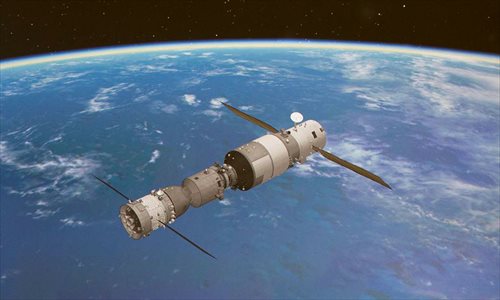

Photo taken on Oct. 19, 2016 shows the screen at the Beijing Aerospace Control Center showing a simulated picture of an automated docking between the Shenzhou-11 manned spacecraft and the orbiting space lab Tiangong-2. The Shenzhou-11 manned spacecraft successfully completed its automated docking with the orbiting Tiangong-2 space lab Wednesday morning, according to Beijing Aerospace Control Center. (Xinhua/Ju Zhenhua)
China plans to conduct some 30 space launch missions in 2017, a record-breaking number in the country's space history, said China Aerospace Science and Technology Corporation.
Long March-5 and Long March-7 rockets will be used to carry out most of the space missions this year, the China News Service reported.
Long March-5 is China's largest carrier rocket. The successful test launch of the vehicle in November in South China's Hainan Province will pave the way for space station construction, analysts said.
Wang Yu, general director of the Long March-5 program, said 2017 is a critical year for China's new generation of carrier rockets and the Long March-5 rockets will carry Chang'e-5 probe to the space. The probe will land on the moon, collect samples and return to Earth.
On the other hand, Long March-7, the more powerful version of Long March-2, will send China's first cargo spacecraft Tianzhou-1 into the space in the first half of 2017, according to Wang Zhaoyao, director of China Manned Space Engineering Office. Tianzhou-1 is expected to dock with Tiangong-2 space lab and conduct experiments on propellant supplement.
China conducted 22 launch missions in 2016 and 19 in 2015. The country successfully tested its Long March-7 rocket in June last year and has gradually shifted to new generation rockets that reduce the use of toxic rocket fuels.
Last Month, China released a white paper on space activities, announcing plans to soft land Chang'e-5 on the moon by the end of 2017 and launch its first Mars probe by 2020.
After Chang'e-5, China will launch the Chang'e-4 lunar probe around 2018 to achieve mankind's first soft landing on the far side of the moon and conduct in situ and roving detection and relay communications at Earth-moon L2 point.
The white paper also says that in the next five years, China will provide space and aviation-related services to countries involved in the One Belt and One Road initiative, such as satellite communications, navigation and weather forecasting analysis. (Global Times)

86-10-68597521 (day)
86-10-68597289 (night)

86-10-68511095 (day)
86-10-68512458 (night)

cas_en@cas.cn

52 Sanlihe Rd., Xicheng District,
Beijing, China (100864)

